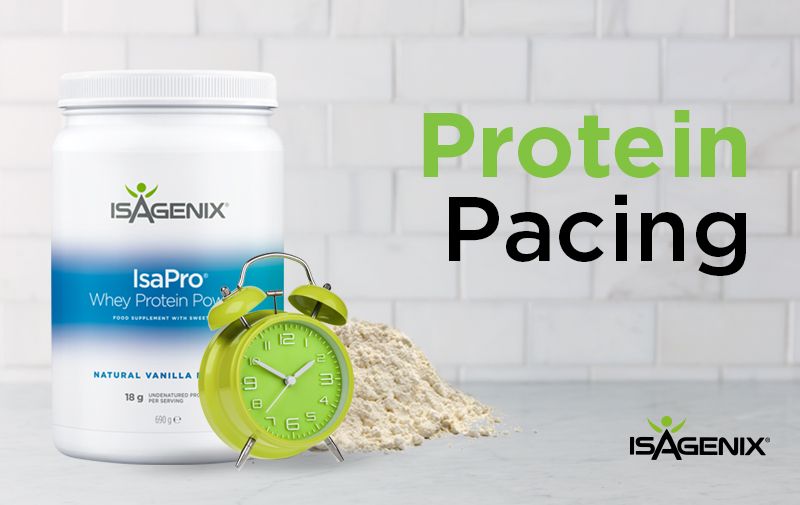Maximise Performance with Protein Pacing
November 29, 2017,
Rebecca Haresign

It’s well known that protein is an essential part of our diet, but how much thought do you give to the timing of your protein intake? Recent research has shown the benefit of consuming several servings of protein-rich foods spread evenly throughout the day to maximise muscle building and athletic performance, a concept referred to as protein pacing.
Many people are aware of the benefits of consuming protein post-workout, but what do you know about when to consume protein throughout the day? Dr Paul Arciero, a key figure in this research, defines protein pacing as the scientifically proven combination of eating healthy, lean protein-rich foods at the right time of day to maximise health and performance.
Typical eating patterns
A typical Western eating pattern tends to be carbohydrate-rich meals for breakfast and lunch, and then include a large portion of protein-rich foods in the evening meal. However, recent research carried out by Dr Arciero and others, found that consuming the right amount of protein spread evenly over four to six meals and snacks can help to reduce body fat, increase lean body mass and help to burn more calories (1). This suggests that following the concept of protein pacing as an eating pattern can maximize muscle maintenance during weight loss and muscle building when combined with exercise.
Research also suggests that protein pacing could enhance energy expenditure and improve body composition with less calorie restriction, as protein-rich meals are known to have a greater thermic effect than carbohydrate-rich meals, meaning more energy is required to digest, absorb and metabolise the protein-rich meals (1, 2).
The type of protein you’re consuming is also relevant as dietary proteins that contain all the essential amino acids, and higher concentrations of the branched-chain amino acids such as leucine, maximally stimulate muscle protein synthesis (3).
How to make protein pacing work for you
- Consume at least 0.75 grams of protein per kilogram of bodyweight every day. This is the minimum amount a person should consume to avoid deficiency. As you become more active your protein requirements can increase to up to 2 grams per kilogram of bodyweight, to support your body’s need to build and repair muscle tissues (4-6).
- Spread your protein intake throughout the day over four to six meals and snacks. For example, you might plan to have three meals and two snacks during the day.
- Consume similar amounts of protein, between 20-30 grams, at each meal and snack.
This eating pattern may seem challenging to some, however protein pacing is easily achieved with Isagenix. Products like IsaLeanTM Shake, IsaPro® and IsaLeanTM Bars make protein-rich meals and snacks easy, convenient and delicious! These products provide high-quality undenatured whey protein which contains all the essential amino acids, a high concentration of branched-chain amino acids and are perfect for consuming whether you’re at home or on the go.f
References
- Arciero PJ, Ives SJ, Norton C, Escudero D, Minicucci O, O’Brien G, Paul M, Ormsbee MJ, Miller V, Sheridan C, He F. Protein-pacing and multi-component exercise training improved physical performance outcomes in exercise-trained women: PRISE 3 study. Nutrients2016, 8(6), 332; doi:3390/nu8060332
- Skidmore P. Macronutrient intake and their role in obesity Nutr Bull2007;32(suppl 1):4-13.
- Hulmi JJ, Lockwood CM, Stout JR. Effect of protein/essential amino acids and resistance training on skeletal muscle hypertrophy: A case for whey protein. Nutr Metab (Lond) 2010; 7:51.
- British Nutrition Foundation. Nutrition Requirements. 2016. Available at: https://www.nutrition.org.uk/attachments/article/234/Nutrition%20Requirements_Revised%20Oct%202016.pdf (accessed 30thAugust 2017)
- Phillips S. Dietary protein requirements and adaptive advantages in athletes. Brit J Nutr2012;108:S158-S167
- Egan B. Protein intake for athletes and active adults: Current concepts and controversies. Nutr Bull 2016;41:202-213.




